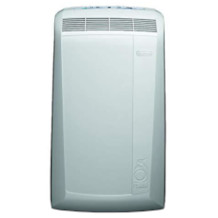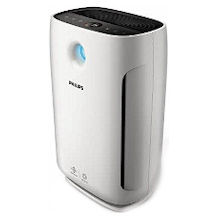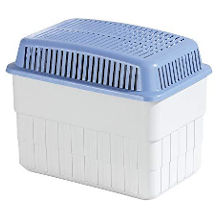Ceiling fan purchasing advice: how to choose the right product
- The most important facts in brief
- Ceiling fans provide pleasant air circulation in summer with a cooling effect for the skin; in winter they support efficient heating.
- They circulate the air in the room, so there is no unpleasant draught, as is the case with floor fans.
- When choosing a ceiling fan, weight is important – here, buyers must pay particular attention to the load-bearing capacity of the ceiling on which the unit is to be mounted.
- Since ceiling fans are permanently mounted, their design should match the interior design – there is a very wide choice of different colours and materials.
For gentle cooling
When temperatures rise in summer, it quickly becomes unpleasantly humid within your own four walls. Especially when it doesn’t cool down noticeably at night and even open windows don’t bring any relief, a solution is needed quickly.
Ceiling fans are not only pleasantly quiet, but also ensure particularly gentle air circulation. This makes them ideal even for the bedroom and helps you fall asleep on tropical nights. At high temperatures, they generate an air current that causes evaporative cooling on the human skin and thus simulates a cooler room climate. However, the room air itself is not cooled down – unlike with air conditioners.
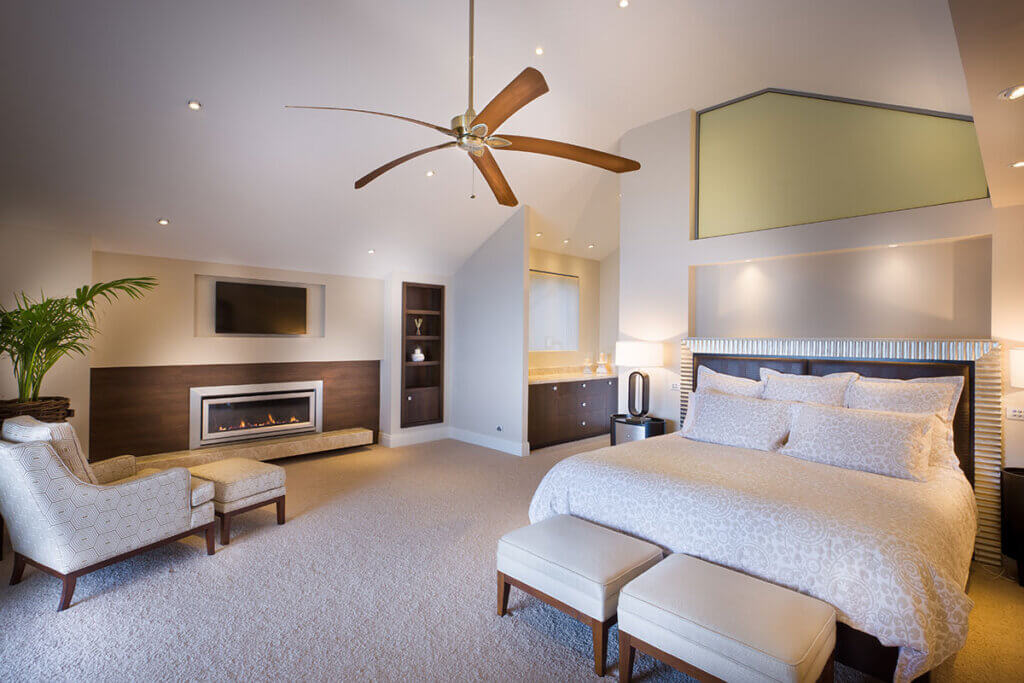
The even air circulation also has a positive effect in winter, because ceiling fans distribute the warm heating air optimally in the room and thus help to save heating costs.
How does a ceiling fan work?
The blades of the ceiling fans rotate around their own axis and thus circulate the air throughout the room. The resulting air flow creates the feeling of a cooler room climate and thus provides a pleasant cooling even in sweltering heat. Unlike floor and table fans, the air circulates very evenly in the room and there are no localised draughts. Ceiling fans are also quieter and can also be used in winter in left-handed operation to swirl the warm air rising upwards back downwards and thus ensure more efficient heat distribution. The resulting gentle draught cools the skin and allows the thin film of sweat on the surface to dry: this creates evaporative cooling. The latter provides users with a pleasant cooling effect in hot and humid air.
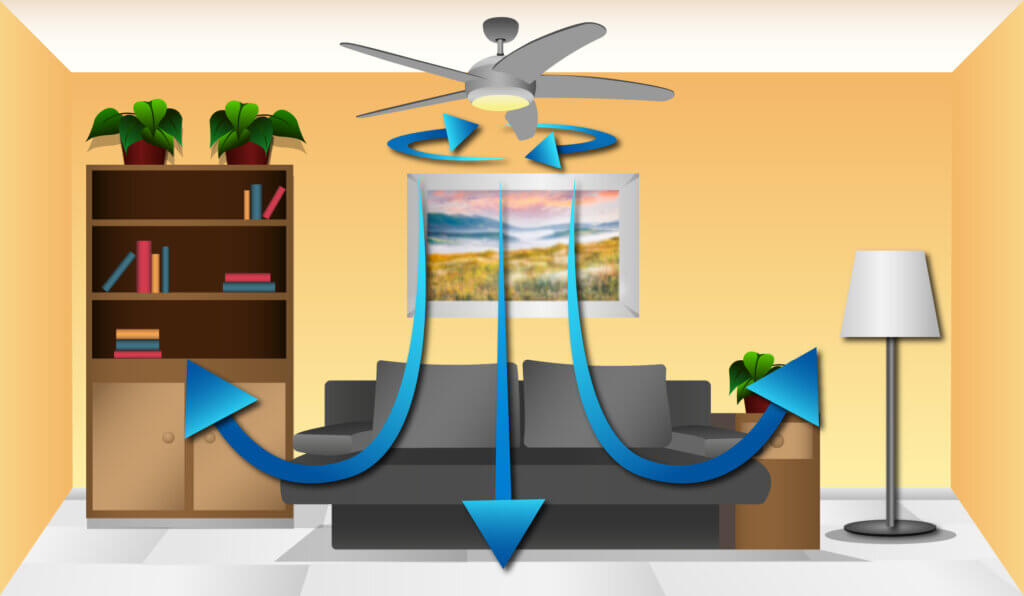
Types of fans in distinction to ceiling fans
Modern fans are available in various designs. In addition to ceiling fans, there are practical small models for the table, which are very suitable for working, for example. Even smaller and handier are USB fans that can be connected to the computer via the USB port, for example. The advantage of these compact devices is that they provide individual cooling without disturbing colleagues.
Floor fans are also very compact and therefore well suited for the office – they have a small, low stand and can generate a very strong air flow. Floor fans are more suitable for larger rooms; here, the rotor head is mounted on a long stand so that the whirled-up air can be distributed over a very wide area. So-called tower and column fans do not need rotors at all. These models use a rotating axis made of blades that circulates the air.
Is it worth buying a ceiling fan?
ceiling fans have a number of advantages over the other types. They are quiet and, thanks to the large-area air circulation, they do not produce an unpleasant draught but a gentle air circulation. Unlike air conditioners, which also have a negative effect on the environment, they do not cool the room air, but simulate a more pleasant room climate through the evaporative cooling on the human skin.
Thanks to their ability to positively influence the indoor climate even at lower temperatures, ceiling fans can be in use all year round. This makes them ideal for your own four walls. They also do not take up any living space and can be combined with the ceiling lamp. There are now many different designs as well as more elegant and less bulky models that can be integrated well into the room.
The following overview summarises the advantages and disadvantages of ceiling fans compared to the other variants:
Advantages
- Space-saving installation on the ceiling
- Large-area air circulation
- Easy to operate
- Can replace a ceiling lamp
- Quiet
Disadvantages
- Mostly fixed and therefore always visible
- Not suitable for all ceilings
- Certain minimum room height required
- Expensive
What should I look for when buying a ceiling fan?
The most important criterion when buying a ceiling fan is the size of the room in which it will be used. The larger the room, the larger the total area of all blades should be. The diameter of the fan limits the maximum size of the room in which it can be used effectively. The number of blades, on the other hand, does not play a decisive role for the range or performance of the fan. In addition to design and weight, attention should also be paid to consumption and operating noise.
Lighting
Since it is advisable to mount the ceiling fan centrally in the room to ensure even air circulation, there are many models that have integrated lighting. In this way, you can combine the ceiling lamp with the fan. The fan and the lighting function can be switched on and off separately. In some models, both the light and the power level of the fan can be controlled via a remote control.
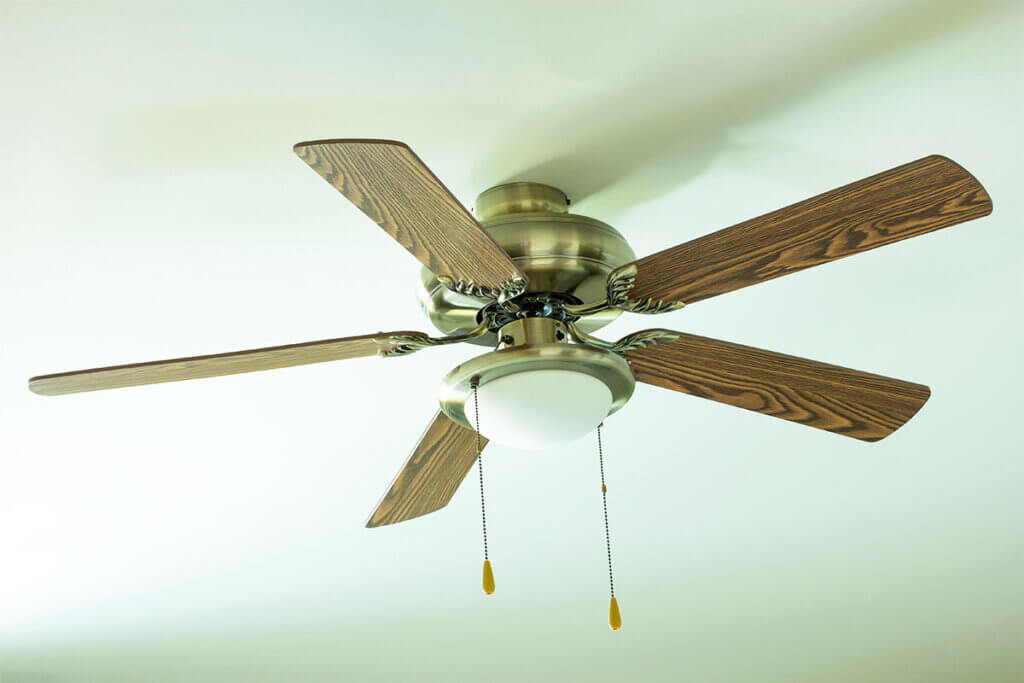
Power levels
Different power levels are a must for ceiling fans in order to achieve the right room climate at any temperature. For a good range, the motor must have a high output. Therefore, fans should have at least three different power levels – five or even the possibility to adjust the power continuously are better.
Winter operation
If you want to benefit from your ceiling fan even in winter, you should make sure that the device has a reverse or left-hand operation. This way, the warm air that rises upwards is swirled back downwards and in this way evenly distributed in the room. In fact, ceiling fans can reduce heating costs by up to 30 percent.
Commissioning
Ceiling fans are installed in exactly the same way as ceiling lamps: first you have to attach a bracket. Then you wire the ceiling fan. It is important that there is a connection to the mains at the chosen location and that the ceiling is stable enough to support the weight of the ceiling fan. Ceiling fans are operated either by a remote control, a wall switch or a pull cord.
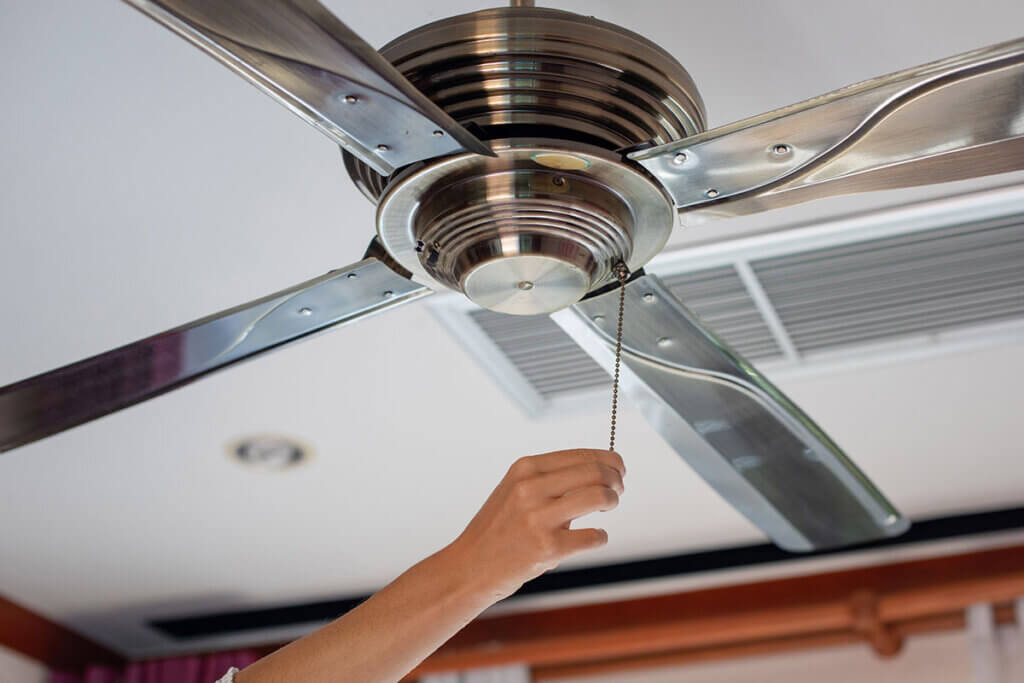
Timer
If you are looking for a ceiling fan for your bedroom but don’t want the unit to run all night, it is best to go for a model with an integrated timer. This works in a similar way to a television, which switches itself off after a certain time.
Wing diameter
The right size of blades depends on the size of the room. For larger rooms, a fan with longer blades is recommended to be able to circulate enough air. In very large rooms such as open-plan offices, halls and rooms, several fans can be used. Basically, the following recommendation applies for the right choice of size:
| Room size | Recommended wingspan |
| Up to 10 square meters | 70 centimeters |
| Up to 15 square meters | At least 105 centimeters |
| More than 20 square meters | At least 132 centimeters |
Material
There are many differences in materials. Very cheap models are often not very well made and are made of cheap plastic. Higher quality units are often made of wood, metal or sturdy plastic – it is important that the individual components are well made. High-quality models also use layers of nickel or chrome to give the ceiling fan a particularly noble appearance. Also with the screws, only a robust and stable quality ensures the necessary longevity.
Weight
The weight of ceiling fans can vary considerably. On the one hand, this is due to the different sizes of the units and the number of blades. But the material used also has an influence on the weight of the fans. The main factor here is the load-bearing capacity of the ceiling on which the ceiling fan is to be mounted. ceiling fans for home use usually weigh between six and nine kilograms.
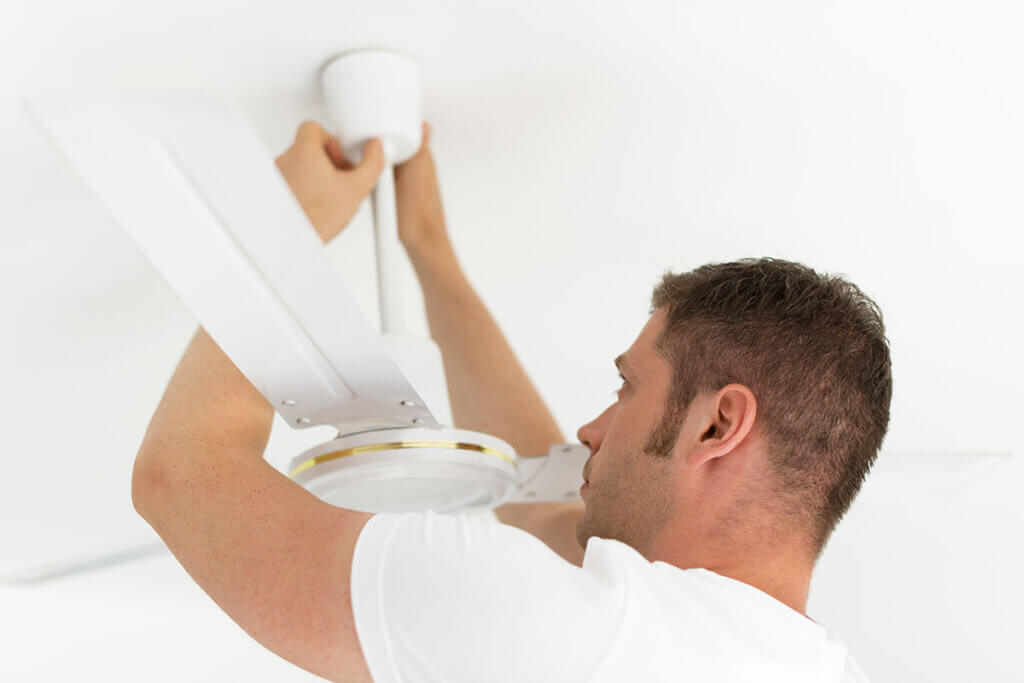
Power consumption
ceiling fans consume relatively little electricity. Because of their large blades, they do not need to run at high speed to generate sufficient air circulation. Therefore, most devices consume a maximum of about 60 to 80 watts per second at the highest power level, and sometimes even only 20 watts at lower power levels.
Operating noise
Especially when used in the bedroom, the volume of the ceiling fan is an important purchase criterion. A maximum volume of about 50 decibels is recommended, which is comparable to the quiet chirping of birds. At lower power levels, the operating noise is sometimes well below this value.
Colour and design
ceiling fans are now available in many different colours and shapes. There is a suitable model for every taste and every interior design. Since ceiling fans are permanently installed, it is important that they match the existing furnishings and colour scheme. There are even models whose blades have a different colour on each side. By turning the blades upside down, the fan can be adapted to the interior design as desired.
Costs
Good models are available from around 100 to 150 euros. The price range for ceiling fans is very high, however, as the devices differ greatly not only in their features but also in the materials and designs used. Buyers can quickly spend over 1,000 euros for a particularly elegant designer piece, but can also get particularly inexpensive models for as little as about 20 euros. The operating costs are comparatively low because of the low consumption: at an electricity price of 25 cents per kilowatt hour and an output of 60 watts, the devices come to about 1.5 cents per operating hour.

Helpful hints and tips
When installing and operating ceiling fans, there are a few mistakes you can make as a do-it-yourselfer and later user of the stylish air dispensers. We provide some helpful tips to ensure that you get the most out of ceiling fans.
Consider the load-bearing capacity of the ceiling
Too much weight can cause the unit to break out of the ceiling. The load-bearing capacity of the ceiling should be at least 50 kilograms, and correspondingly more for heavy ceiling fan models. While you do not need to worry about this with stable ceilings made of wood or concrete, you should rather go for a lightweight model if the ceiling is unstable. Alternatively, special dowels can be used to ensure a more stable attachment.
Match the construction method to the ceiling height
If you have a very low ceiling, you should make sure that the construction method is particularly flat, otherwise residents and guests can painfully bump their heads.
Determining the centre of the room
If you want to provide pleasant cooling not only above a certain area, such as the sofa set, but cover the entire room, you should install the ceiling fan as centrally as possible. If a lamp is already installed, it often hangs in the middle of the room. Otherwise, determine the centre of the room using a tape measure or diagonal chalk lines. The point of intersection indicates the desired installation location.
Safe mounting
During assembly, safety dictates that the power supply be disconnected before the first actual work step. For example, you can only switch off the actual circuit by pressing the light switch. In this case, you should secure the light switch against being switched on again unintentionally, for example by using fabric tape or gaffer tape. Alternatively, switch off the corresponding fuse or the main switch. If there is already an existing lighting installation, remove it before installation and disconnect it from the connecting cables.
Saving electricity with well thought-out use
ceiling fans should only be used when there are people in the room, as they do not cool down the room temperature. Therefore, the fans should be switched off when no one is in the room to save electricity.
Mobile alternatives
As an alternative to a ceiling fan, another form of cooling can be chosen. Pedestal and tower fans can be easily placed in the room and connected to the power supply without installation. The advantage with these devices is that they can be placed in another room as needed. Smaller hand fans and mini fans are practical devices for mobile use. They are operated either by battery or USB connection and thus offer ideal cooling for in between.

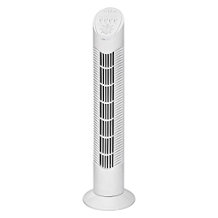
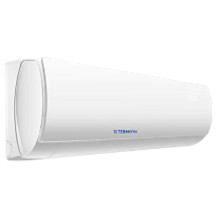
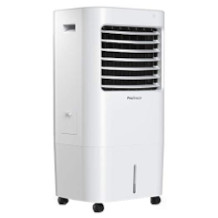

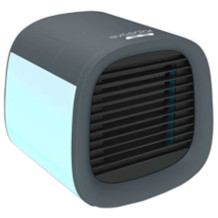

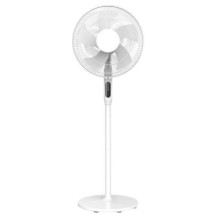
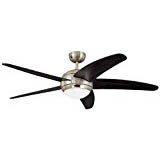
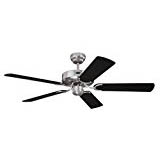
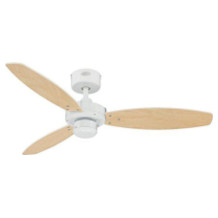
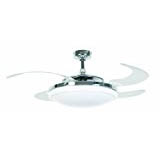
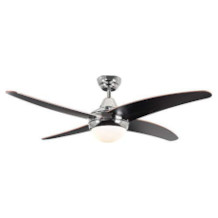
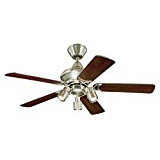
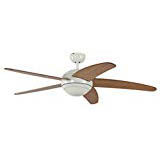
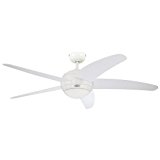
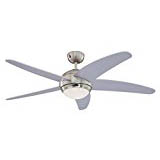
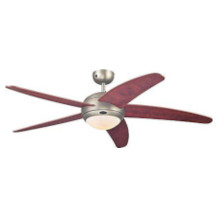
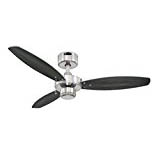
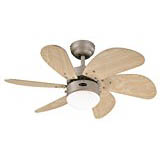
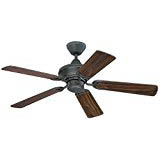
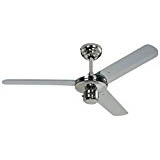
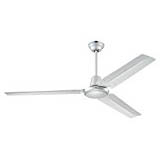

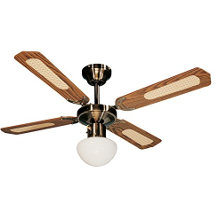
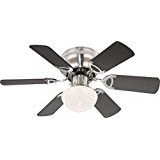
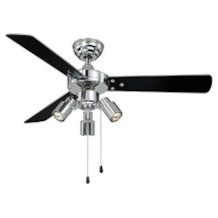
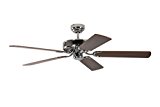
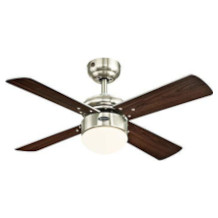
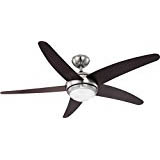
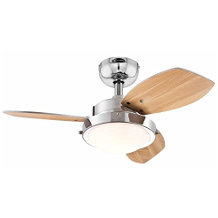
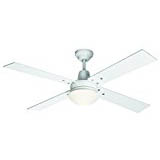
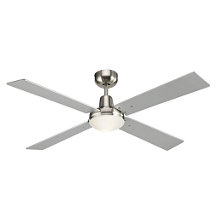

 5,101 reviews
5,101 reviews


